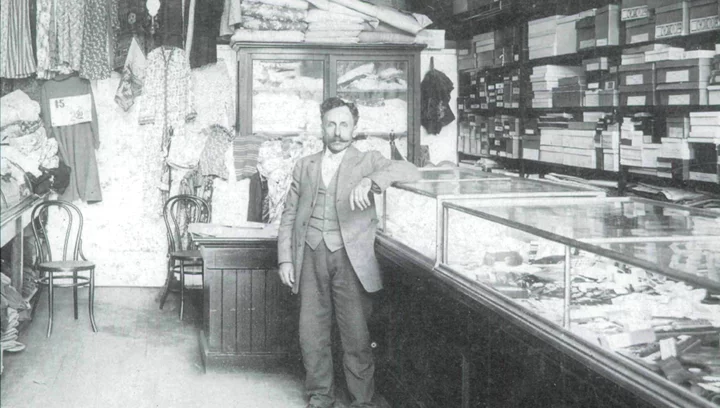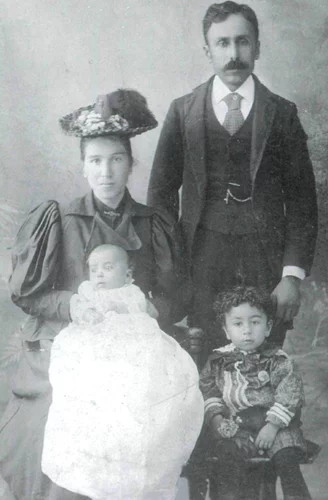Davis Schemoon in his clothing store at Second and E streets, current home of the Irish Shop. Photos via the Humboldt Historian.
My grandfather, Davis Schemoon, came to the United States from that war-wracked country we today call Lebanon. He was ethnically Syrian, since there was no Lebanon in those days. His passport indicated he was a citizen of the Ottoman Empire, as Turkey owned practically all of the Near East at that time.
“Grampa,” as all of us grandchildren called him, was born in 1860 in the mountain resort town of Zahle, located in the Bekaa Valley amid the Anti-Lebanon Mountains. The village was one-half Christian and one-half Muslim. He was a Maronite Christian. The church was named after Maron, a bishop in the very early Christian church.
After attending American University in Beirut, Davis came under the wing of American Presbyterian missionaries at that school. This was fortunate for him, because those missionaries sponsored Davis to come to the United States and sent with him letters of introduction to people here. The missionaries described him as a moral man and a good businessman. They were correct. Davis remained in business the rest of his life and attended church regularly.
Davis Schemoon came as an immigrant to this country in 1887, in the first boatload of newcomers from the Near East. Since he could speak English fairly well and had education beyond that of the average immigrant, he was asked to talk about his native area through the Chautauqua traveling lecture series in upstate New York. He spoke on the Arabic language, the customs, religious history and geography of the land of his origin. In 1890, after lecturing on the circuit for several years, he traveled west to San Francisco. There, he bought a house on Telegraph Hill just below Coit Tower. Davis paid $900 for the property, which he later sold. Today, because of its location and outstanding view, that home - which is still standing - would sell for close to $1 million.
After working in San Francisco for a year, Davis sent for his wife, Amelia, who had remained overseas while he was making enough money in the United States to support them. Three of their eight children, George (known as Toofy), Alfred (Najeeb) and my mother, Mary, were born in San Francisco. Their other children, Joseph (Yusef), Kelly, William, Amelia, and their youngest, Edward (Assad), were all born in Humboldt County.
North on the Pomona
Davis first heard about Humboldt County in 1896 from a fellow countryman who was living in this area. That same year, he and his growing family boarded the steam schooner Pomona and came to the North Coast. The family’s new home — located at 226 West Grant Street in Eureka — sat between Pine and Summer streets. It is still there today. The Schemoons’ neighbors included the Berrys, who lived across the street; the Toninis who lived around the corner; and Sergeant Hill of the Eureka police force and his family who lived on the west side of Summer Street. The Pinochis, who owned the Butternut Bakery, resided next to the Hills, and the Fred Moore family was just up Grant on B Street.
For his first local business venture, Davis put a large leather container filled with clothes and various sundries on his back, and peddled them Near Eastern-style in Eureka and as far away as Blue Lake. Later, he bought a team of horses and a wagon and sold his wares all the way to Hoopa. His route took him near the old Highway 299 over the Lord-Ellis Road and down into Redwood Creek, then down river for a few miles until he hit the old road that ended on the south side of Hoopa. Since no one had much cash in those days, a barter system was often used. At one time, Davis had accumulated a whole room full of Native American baskets and other artifacts. The collection would have been priceless today, but it disappeared when the younger Schemoon siblings rented out the family home and moved back to San Francisco during World War II. Fresh out of the Army, I came back to Eureka to visit in 1946. I checked on those baskets during my stay, but I was too late. Someone had realized their worth and taken off with them.
A Budding Businessman
In 1907, Davis opened up a clothing store right across Second Street from where the Eureka Rescue Mission is now located. A few years later, Davis — who wanted to move up Second Street a bit closer to town — closed his first store. In 1912, he started a second clothing store called Davis Schemoon and Son since his oldest child, George, was working with him by then. This new clothing store was located at the corner of Second and E streets, home of today’s Irish Shop. Uncle George worked for my grandfather until he joined the Army and was sent to France during World War I. The clothing store closed shortly after the war was over.
Years later, my grandfather started two grocery stores in Eureka. The first one, located on the corner of Summer and Grant streets, opened in 1922. The second store, on the corner of Summer and Simpson streets, opened in 1926. The latter — run by my Uncle George — was across the street from the Eureka Auto Camps, then the name for a trailer park or motel. There were cabins on the grounds, I remember, as well as places to pitch tents. Ancient cypress trees surrounded the Auto Camp. My cousins, George and Helen Schemoon, my brother Jim, and I spent many happy hours climbing on those large trees when we were young.
Davis ran the grocery store at Grant and Summer streets. The Tonini girls, Anna and Lilly, came to that store often to buy hairnets. Mr. Dixon, who lived up on Union Street, preferred the strong Toscani cigars. Kids in the neighborhood would congregate around the penny-candy counter. A big stock of bananas was always hanging in the window of the store. Most customers wanted to cut bananas from the stock themselves. A curved knife was there to accommodate them. In the back of the store was an old-fashioned coffee grinder. The wheel on the grinder was four feet in diameter. Coffee beans came in bulk form in a sack so customers could have my grandfather grind as little or as much as they desired.
A Tragic Accident
Early in the century, the streetcar line was extended out Summer Street to Broadway and out Broadway to Bucksport. The track ran right alongside my grandfather’s store. My grandfather still had a team of horses and a wagon then and my Uncle Kelly would usually accompany him while he was delivering the groceries. My uncle and grandfather were down on Broadway one day. The streetcar tracks had just been put in. The horses were unfamiliar with the clangs and bells of the trolleys and they shied and Grampa and his brother were thrown to the ground. My grandfather landed on the street and, with the exception of a few bruises, was OK. Uncle Kelly, however, landed on his back squarely on the tracks. He was disabled for life. He became a familiar sight around town, selling various sundries out of a drawer from his wheelchair.
Closing Shop
After working as a businessman for many years, my grandfather retired and turned his stores over to George and Edward. George’s store burned down in a spectacular fire in the 1930s. In 1942, Edward — who was operating the store my grandfather had managed — went into the service. He closed the store down and never returned to Eureka. Edward was the last person to carry the name Schemoon around here.
In 1965, remaining family members sold all the property Davis had accumulated over the years. Today, there is a private home and a dry cleaning establishment on the lot where George’s grocery store once stood. The other store is still standing, though it is used as a warehouse.
Grampa died in Eureka in 1935 at the age of seventy-five. His funeral was one of the largest in this area at that time. Relatives and friends came all the way from Lebanon to attend. He is buried along with my grandmother, one aunt, and two uncles at Ocean View Cemetery in Eureka.
###
The story above was originally printed in the Summer 2000 issue of the Humboldt Historian, a journal of the Humboldt County Historical Society. It is reprinted here with permission. The Humboldt County Historical Society is a nonprofit organization devoted to archiving, preserving and sharing Humboldt County’s rich history. You can become a member and receive a year’s worth of new issues of The Humboldt Historian at this link.


CLICK TO MANAGE